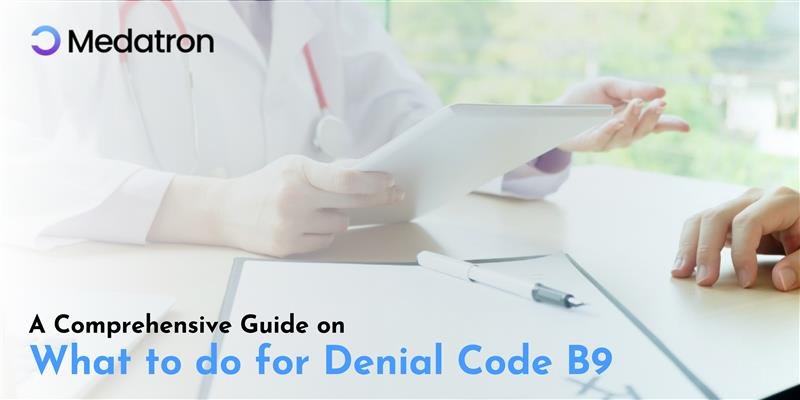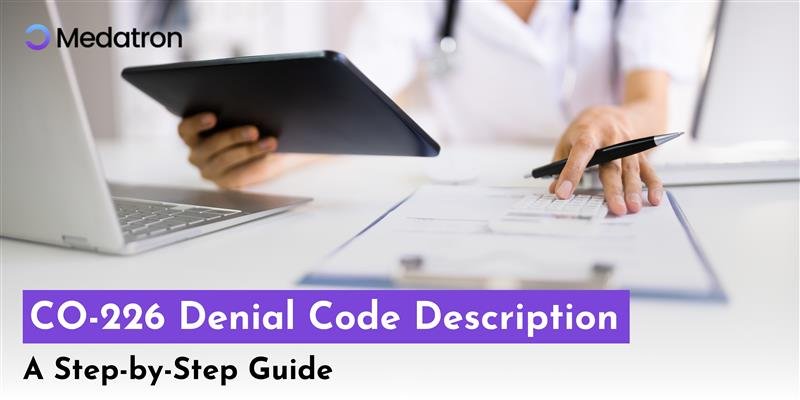When working in the healthcare sector, you will face denials on claims. One of the standard denial codes is Denial Code B9. The main reason for this denial is that the healthcare provider does not follow Medicare’s hospice care guidelines. While the cause of this denial appears to be self-evident, it may not be easy to resolve without having an idea of what is happening. Let’s get into what to do for denial code B9, why it happens, and how you can manage it effectively.
What is Denial Code B9?
Denial Code B9 mainly addresses errors in billing for hospice care claims. Upon release of this code, this would mean that the services rendered to the patient are related to their terminal condition. The hospice should cover these services; the healthcare provider cannot separately bill such. Most hospice care plans in a Medicare Part A account shall cover services related to the patient’s terminal illness. In contrast, Medicare Part B services should cover services unrelated to the terminal illness. If the services are incorrectly billed to Medicare instead of the hospice provider, the claim will be denied with the B9 code.
Common Reasons for Denial Code B9
Many factors can lead to a B9 denial code, most of which can be avoided. Knowing what these reasons are will help in preventing future denials:
Billing for Services Already Covered by Hospice
The most common cause of the B9 denial code is billing for services already covered by the patient’s hospice care plan. Any services related to the patient’s terminal illness should be billed directly to the hospice provider. If these services are submitted to Medicare or another payer, the claim will likely be denied with a B9 code.
To avoid such denials, it is essential to work with reliable Medical Billing Services that are experienced in hospice billing, ensuring accurate submissions and timely processing.
Incorrect Use of Modifiers
If the patient is being provided with services that are not directly related to the terminal condition, modifiers are required. GV designates that the attending physician is an employee of the hospice provider, whereas GW is used if the services rendered are not directly related to the terminal condition. If these modifiers are not used, then all services will be paid, which would lead to a denial at the B9 level.
Inadequate Verification of Hospice Enrollment:
Another common problem is not verifying a patient’s enrollment status in the hospice program before sending claims. If the patient is, in fact, in hospice, all associated services must be submitted via the hospice provider rather than filed separately through other healthcare providers.
Inadequate or Incomplete Documentation
Insurance companies usually deny claims when the documentation is vague or incomplete. Without proper evidence proving that those services were either part of the hospice care or unrelated to the terminal condition, the insurance company will not allow the claim; hence, the B9 denial code.
Action Plan for Resolution of B9 Denial Code
Do not panic; you’ve received a denial letter with the B9 code. Follow the steps below to learn how to do it quickly.
Check Denial Reasons Thoroughly
To see why the claim was denied, look at the Explanation of Benefit (EOB) or Electronic Remittance Advice (ERA). Confirm that the denial is patient-specific and related to hospice care and verify that the issue is billing the wrong services.
Verify Hospice Enrollment Status
Confirm that the patient is enrolled in hospice care, as this will guide your next steps. If the patient was incorrectly listed as not enrolled in hospice, you must correct this before resubmitting the claim.
Assess the Nature of the Services
Determine if the services are related to the patient’s terminal illness. If they are, they should not be billed separately. If they are not related, proceed to the next step.
Verify Correct Modifiers
Verify that the claim includes the GV or GW modifiers:
- GV modifier: This is used when the attending physician is not part of the hospice team.
- GW modifier: This is used when the services are unrelated to the terminal illness.
If your claim was missing any of the correct modifiers, edit the claim and resubmit it.
Edit and Resubmit the Claim
Once all the details have been checked and the necessary modifiers added to the claim, resubmit it. Remember to include all related documentation to prove that those services were unrelated to hospice care.
File an Appeal if Required
If you think the request has been unfairly rejected, make an appeal. Keep enough documents and a proper description of the reasons why it should be separately paid from the hospice care plan.
Trucking Insurance Company
Submitting a corrected claim and appealing a claim call for a track record of following the claim by an insurance company so that one can avoid payment delays without unnecessarily needing to undergo a delay.
Prevention of B9 Denial Code: How to Avoid It
There is no better way than preparation to avoid dealing with the issue of a B9 denial. Here’s how to prevent future occurrences of the B9 code:
Hospice Enrollment Confirmation
Ensure that the patient is actually under hospice enrollment before submitting a claim. This is crucial to ensuring the services billed are to the right provider.
Familiarize Yourself with Medicare’s Hospice Care Guidelines
Understanding how Medicare covers hospice care is critical to avoiding mistakes. Services related to the patient’s terminal condition are covered by Medicare Part A and should be handled by the hospice provider. Non-terminal services may fall under Medicare Part B, and these can be billed separately.
Use Correct Modifiers
Ensure that all services unrelated to the terminal condition have proper modifiers. This will further explain that the services do not fall under the hospice care plan, minimizing the chances of denial based on B9.
Keep Thorough Documentation
Keep track of the services rendered and if these have any link with the terminal illness. Complete records help show that there was indeed a need for these services to be done, thereby correctly processing by the insurance company.
Partner with the Hospice Provider
Be involved with your hospice provider. Discuss the care plan and know what will likely confuse your bill.
Train Your Billing Team
Hospice care guidelines and the proper application of modifiers should be continually taught to your billing staff so they do not lead to B9 denials. Make sure that the rules are known to them and update them frequently with changes in billing practice.
Implement Verification and Auditing Process
Carry out a comprehensive verification and audit process to ensure claims are checked through properly before submission. The process shall involve checking for the patients’ hospice enrollment to ensure that correct modifiers and documentation exist.
Conclusion
Denial Code B9 can be irritating, but it is an issue one can control if approached appropriately. To mitigate the likelihood of receiving this code, take proactive measures and verify enrollment into hospice using proper modifiers and correct documentation. The time and effort it takes to train your billing team and improve communication between you and your hospice providers can help reduce denial codes that lead to the hassle and inefficiency in claims processing.
By associating your claims with accurate information and adhering to Medicare’s guidelines, you can avoid Denial Code B9 in hospice care billing. Medatron‘s advanced billing solutions allow you to verify hospice enrollment status, use proper modifiers, and document information appropriately. Integrating Medatron into your workflow helps you minimize errors, reduce denials, and get a smooth reimbursement cycle for your claims.





